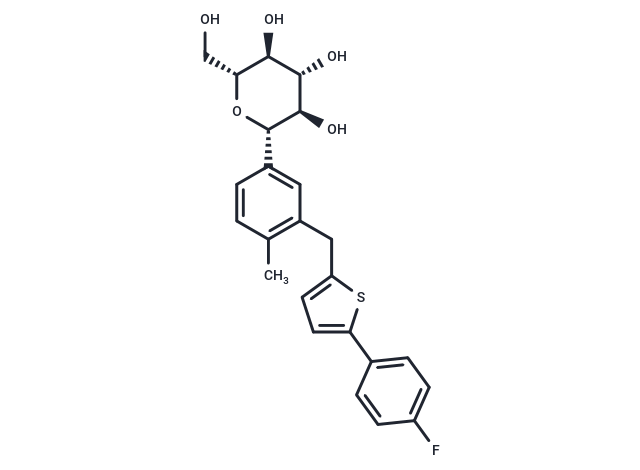Shopping Cart
- Remove All
 Your shopping cart is currently empty
Your shopping cart is currently empty

Canagliflozin (JNJ 28431754AAA) is a selective SGLT2 inhibitor that inhibits CHO cells expressing mSGLT2, rSGLT2, and hSGLT2 (IC50=2/3.7/4.4 nM). Canagliflozin can be used for the treatment of type II diabetes mellitus (T2DM).

| Pack Size | Price | Availability | Quantity |
|---|---|---|---|
| 5 mg | $43 | In Stock | |
| 10 mg | $61 | In Stock | |
| 50 mg | $97 | In Stock | |
| 100 mg | $125 | In Stock | |
| 200 mg | $185 | In Stock | |
| 500 mg | $313 | In Stock | |
| 1 mL x 10 mM (in DMSO) | $48 | In Stock |
| Description | Canagliflozin (JNJ 28431754AAA) is a selective SGLT2 inhibitor that inhibits CHO cells expressing mSGLT2, rSGLT2, and hSGLT2 (IC50=2/3.7/4.4 nM). Canagliflozin can be used for the treatment of type II diabetes mellitus (T2DM). |
| Targets&IC50 | SGLT2 (human):4.4 nM, SGLT2 (mouse):2 nM, SGLT2 (rat):3.7 nM |
| In vitro | METHODS: CHOK-hSGLT1 and CHOK-hSGLT2 cells were incubated with Canagliflozin (0.01-10000 nM) for 10 min and sodium-dependent glucose uptake was detected. RESULTS: Canagliflozin inhibited 14C-AMG uptake in CHO-hSGLT1 and CHOK-hSGLT2 cells with IC50 of 684±159 nM and 4.4±1.2 nM, respectively.[1] METHODS: Human umbilical vein endothelial cell HUVECs were treated with Canagliflozin (1-50 µM) for 24 h and DNA synthesis was measured to monitor cell proliferation. RESULTS: Treatment of HUVECs with Canagliflozin resulted in a concentration-dependent inhibition of DNA synthesis. The ability of Canagliflozin to block DNA synthesis was observed at concentrations (5-10 µM) achieved in the plasma of patients receiving Canagliflozin. In addition, higher concentrations of Canagliflozin (50 µM) virtually eliminated DNA synthesis. [2] |
| In vivo | METHODS: To study the efficacy of treatment of type 2 diabetes mellitus (T2DM), Canagliflozin (0.1-30 mg/kg, 0.5% hydroxypropyl methylcellulose) was administered by gavage to four animal models. The animal models included: (1) male C57BL/6J mice fed a high-fat diet; (2) male C57BL/ksj-db/db hyperglycemic mice; (3) male Zucker fatty (ZF) obese, insulin-resistant rats; and (4) male ZDF obese, hyperglycemic rats. RESULTS: Canagliflozin decreased RTG and increased UGE, improved glycemic control and β-cell function, and reduced body weight gain in a rodent model of T2DM. [1] |
| Cell Research | Cells from the rat skeletal muscle cell line, L6, is used to test the effect of Canagliflozin on glucose transporter 1 (GLUT1) activity. Cells are maintained in Dulbecco's modified Eagle's medium containing 5.6 mM glucose supplemented with 10% fetal bovine serum, are seeded in 24-well plates at a density of 3 × 105 cells/well and cultured for 24 hours in an atmosphere of 5% CO2 at 37 °C. Cells are rinsed twice with Kreb's ringer phosphate HEPES buffer (pH 7.4, 150 mM NaCl, 5 mM KCl, 1.25 mM MgSO4, 1.25 mM CaCl2, 2.9 mM Na2HPO4, 10 mM HEPES) and are pre-incubated with the solutions of Canagliflozin (250 μL, 10 μM) for 5 minutes at room temperature. The transport reaction is initiated by adding 50 μL of 4.5 mM 2-DG (a substrate for GLUTs)/3H-2-DG (0.625 μCi) followed by incubation for 15 minutes at room temperature. The 2-DG uptake is halted by aspiration of the incubation mixture. Cells are immediately washed 3 times with ice-cold PBS. Samples are extracted with 0.3 N NaOH, and radioactivity is determined by liquid scintillation.(Only for Reference) |
| Alias | TA 7284, JNJ 28431754AAA, JNJ 28431754, JNJ 24831754ZAE |
| Molecular Weight | 444.52 |
| Formula | C24H25FO5S |
| Cas No. | 842133-18-0 |
| Smiles | O[C@H]1[C@@H](O[C@H](CO)[C@@H](O)[C@@H]1O)C2=CC(CC=3SC(=CC3)C4=CC=C(F)C=C4)=C(C)C=C2 |
| Relative Density. | 1.364 g/cm3 |
| Storage | keep away from direct sunlight,keep away from moisture,store at low temperature | Powder: -20°C for 3 years | In solvent: -80°C for 1 year | Shipping with blue ice. | ||||||||||||||||||||
| Solubility Information | H2O: < 1 mg/mL (insoluble or slightly soluble) DMSO: 50 mg/mL (112.48 mM), Sonication is recommended. 10% DMSO+40% PEG300+5% Tween 80+45% Saline: 5 mg/mL (11.25 mM), In vivo: Please add the solvents sequentially, clarifying the solution as much as possible before adding the next one. Dissolve by heating and/or sonication if necessary. Working solution is recommended to be prepared and used immediately. Ethanol: < 1 mg/mL (insoluble or slightly soluble) | ||||||||||||||||||||
Solution Preparation Table | |||||||||||||||||||||
DMSO
| |||||||||||||||||||||

Copyright © 2015-2025 TargetMol Chemicals Inc. All Rights Reserved.